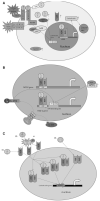Regulation of antimicrobial peptide gene expression by nutrients and by-products of microbial metabolism
- PMID: 22797470
- PMCID: PMC3587725
- DOI: 10.1007/s00394-012-0415-4
Regulation of antimicrobial peptide gene expression by nutrients and by-products of microbial metabolism
Abstract
Background: Antimicrobial peptides (AMPs) are synthesized and secreted by immune and epithelial cells that are constantly exposed to environmental microbes. AMPs are essential for barrier defense, and deficiencies lead to increased susceptibility to infection. In addition to their ability to disrupt the integrity of bacterial, viral and fungal membranes, AMPs bind lipopolysaccharides, act as chemoattractants for immune cells and bind to cellular receptors and modulate the expression of cytokines and chemokines. These additional biological activities may explain the role of AMPs in inflammatory diseases and cancer. Modulating the endogenous expression of AMPs offers potential therapeutic treatments for infection and disease.
Methods: The present review examines the published data from both in vitro and in vivo studies reporting the effects of nutrients and by-products of microbial metabolism on the expression of antimicrobial peptide genes in order to highlight an emerging appreciation for the role of dietary compounds in modulating the innate immune response.
Results: Vitamins A and D, dietary histone deacetylases and by-products of intestinal microbial metabolism (butyrate and secondary bile acids) have been found to regulate the expression of AMPs in humans. Vitamin D deficiency correlates with increased susceptibility to infection, and supplementation studies indicate an improvement in defense against infection. Animal and human clinical studies with butyrate indicate that increasing expression of AMPs in the colon protects against infection.
Conclusion: These findings suggest that diet and/or consumption of nutritional supplements may be used to improve and/or modulate immune function. In addition, by-products of gut microbe metabolism could be important for communicating with intestinal epithelial and immune cells, thus affecting the expression of AMPs. This interaction may help establish a mucosal barrier to prevent invasion of the intestinal epithelium by either mutualistic or pathogenic microorganisms.
Figures

Similar articles
-
Species-specific regulation of innate immunity by vitamin D signaling.J Steroid Biochem Mol Biol. 2016 Nov;164:246-253. doi: 10.1016/j.jsbmb.2015.09.016. Epub 2015 Sep 11. J Steroid Biochem Mol Biol. 2016. PMID: 26369615 Review.
-
Friends or Foes? Host defense (antimicrobial) peptides and proteins in human skin diseases.Exp Dermatol. 2017 Nov;26(11):989-998. doi: 10.1111/exd.13314. Epub 2017 Apr 27. Exp Dermatol. 2017. PMID: 28191680 Review.
-
Bile salts control the antimicrobial peptide cathelicidin through nuclear receptors in the human biliary epithelium.Gastroenterology. 2009 Apr;136(4):1435-43. doi: 10.1053/j.gastro.2008.12.040. Epub 2008 Dec 13. Gastroenterology. 2009. PMID: 19245866
-
Development, validation and implementation of an in vitro model for the study of metabolic and immune function in normal and inflamed human colonic epithelium.Dan Med J. 2015 Jan;62(1):B4973. Dan Med J. 2015. PMID: 25557335 Review.
-
The vitamin D-antimicrobial peptide pathway and its role in protection against infection.Future Microbiol. 2009 Nov;4(9):1151-65. doi: 10.2217/fmb.09.87. Future Microbiol. 2009. PMID: 19895218 Free PMC article. Review.
Cited by
-
Function and Phylogeny of Bacterial Butyryl Coenzyme A:Acetate Transferases and Their Diversity in the Proximal Colon of Swine.Appl Environ Microbiol. 2016 Oct 27;82(22):6788-6798. doi: 10.1128/AEM.02307-16. Print 2016 Nov 15. Appl Environ Microbiol. 2016. PMID: 27613689 Free PMC article.
-
Inflammatory signals that regulate intestinal epithelial renewal, differentiation, migration and cell death: Implications for necrotizing enterocolitis.Pathophysiology. 2014 Feb;21(1):67-80. doi: 10.1016/j.pathophys.2014.01.001. Epub 2014 Feb 16. Pathophysiology. 2014. PMID: 24533974 Free PMC article.
-
Intestinal enteroids recapitulate the effects of short-chain fatty acids on the intestinal epithelium.PLoS One. 2020 Apr 2;15(4):e0230231. doi: 10.1371/journal.pone.0230231. eCollection 2020. PLoS One. 2020. PMID: 32240190 Free PMC article.
-
Evaluation of bile salt hydrolase inhibitor efficacy for modulating host bile profile and physiology using a chicken model system.Sci Rep. 2020 Mar 18;10(1):4941. doi: 10.1038/s41598-020-61723-7. Sci Rep. 2020. PMID: 32188876 Free PMC article.
-
Vitamin D Levels in Children with Adenotonsillar Hypertrophy and Otitis Media with Effusion.Iran J Otorhinolaryngol. 2017 Jan;29(90):29-33. Iran J Otorhinolaryngol. 2017. PMID: 28229060 Free PMC article.
References
-
- Zanetti M. The role of cathelicidins in the innate host defenses of mammals. Curr Issues Mol Biol. 2005;7:179–196. - PubMed
-
- Ganz T, Lehrer RI. Defensins. Pharmacol Ther. 1995;66:191–205. - PubMed
-
- Ganz T. Defensins: antimicrobial peptides of innate immunity. Nat Rev Immunol. 2003;3:710–720. doi:10.1038/nri1180. - PubMed
-
- Nizet V, Ohtake T, Lauth X, Trowbridge J, Rudisill J, Dorschner RA, Pestonjamasp V, Piraino J, Huttner K, Gallo RL. Innate antimicrobial peptide protects the skin from invasive bacterial infection. Nature. 2001;414:454–457. doi:10.1038/35106587. - PubMed
-
- Papagianni M. Ribosomally synthesized peptides with antimicrobial properties: biosynthesis, structure, function, and applications. Biotechnol Adv. 2003;21:465–499. - PubMed
Publication types
MeSH terms
Substances
Grants and funding
LinkOut - more resources
Full Text Sources
Other Literature Sources

